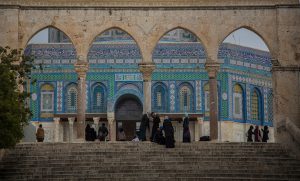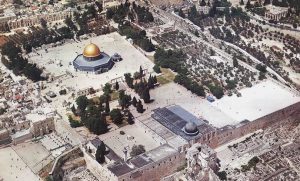Al-Aqsa Mosque has a number of beautiful and graceful domes that adorn the courtyard of the mosque. These domes were built during the periods of Islamic rule from the Umayyad and the later eras such as Ayyubid, Mamluk and Ottoman periods. It is an expression of the interest of Muslims to have an impact and a contribution to the revival of al-Aqsa Mosque. These domes were built for various purposes, such as umbrellas for worshipers or teaching boards or for worship and retreat. The mosque contains 15 domes, as follows:
1) The Dome of the Rock
The Umayyad Caliph Abdul Malek bin Marwan ordered the building of the golden dome between 71-72 AH/691-692 AC on the highest spot of Al-Aqsa Mosque, in the middle of a plateau that is 4 meters higher than the rest of the mosque’s courtyards.
The Dome of the Rock, which is the earliest existing model of Islamic architecture, was built over what Muslims believe to be the Rock of Ascension. It is sitting on top of an octagonal-shaped building with four doors; the building’s dimensions are 20.59 meters in length and 9.5 meters in height.
The dome is based on a circular drum ornamented with faience and decorated with verses from chapter 17 (Al-Isra’) of the Qur’an. The dome has a 2.5-3° indentation in the structure of its circular pillars that grants the person full vision of its interior including the stone columns and pillars if he/she stands at any of its four entrances. A number of arched gates surround the Dome of the Rock’s plateau, but they only serve a decorative function.
2) Dome of the Chain
The Umayyad Caliph Abdul Malik bin Marwan ordered the building of this dome in 72 AH/691 AC. It is located to the east of the Dome of the Rock; although some people believe it was built as a prototype for the Dome of the Rock, yet it is smaller in size and different in shape. Historians differ over the purpose the Dome of the Chain was constructed for. Some say it was used as an exchequer, but this theory is quite unlikely because of the building’s open structure that would make keeping money safe inside of it a very difficult task. Others suggest it was used as a lounge for architects and builders when they were building the Dome of the Rock itself. As for the Dome’s physical characteristics, it is an open building that has eleven sides which are based on eleven marble columns, while the dome is sitting on a hexagonal drum. The faience that decorates the dome was brought to Al-Aqsa Mosque upon the Ottoman Sultan Suleiman the Magnificent’s orders in 969 AH/1561 AC. During the Crusaders’ occupation of Jerusalem the Dome was turned into a church called Saint James. It returned to Muslims’ position after Saladin’s liberation of Jerusalem in 583 AH/1187 AC.
3) The Dome of Ascension
The Dome of Ascension was built in commemoration of Prophet Mohammad’s (PBUH) ascension to heaven (Al-Mi’raj). It is a small octagonal dome based on 30 marble columns; the open space between the columns was later sealed using marble slabs. In the past, the dome was covered with lead sheets, but they were recently replaced by white stone plates. The Dome has a niche pointing towards the Qibla, and its main entrance is located on its northern side. What makes this Dome stand out is the smaller dome on top of it that looks like a crown. The Dome’s accurate year of construction and its founder’s name remain unknown; it was renovated by Prince Ezz Ad-Din Ottoman bin Ali Az-Zanjabily, the Governor of Jerusalem, during the Ayoubi King Al-Adel’s reign in 597 AH/1200 AC
4) Dome of Moses
This dome is located in the middle of the Moses Platform in the western courtyard of Al-Aqsa Mosque. It was built by the Ayoubi King Najm Ad-Din bin Al-Malk Al-Kamel in 647 AH/1249-1250 AC as a place of worship and a sanctuary for clergymen and imams. It has a number of simple niches inside and outside of it. Some historians say that it was named Dome of Moses in tribute to Prophet Moses (PBUH), while others say it was named after a sheikh who used to lead prayers in it. The Dome is also famous by the name the “Dome of the Tree” because of its close location to a huge palm tree that stood next to it in the past.
5) Grammarian Dome
King Issa Al-Moatham ordered building this dome’s basic structure in 604 AH/1207 AC and dedicated it to teaching Arabic language and grammar in particular. In 608 AH/1213 AC he added a dome on top of it. The building consists of two rooms and a hallway in the middle that is topped with two domes: the big silver dome lies on top of the western room, the smaller dome sits on top of the eastern room, while the hallway’s roof is flat. The dome’s entrance is located on its northern side, and is decorated with two marble columns famous by the name of the “Unthankful Son.” The structure remained a school until the 12th Century AH and has played a great role in Jerusalem’s cultural and intellectual scene and continued to be a school for Arabic language and grammar until the 12th Century AH. During the past century the dome was used as a library for the Islamic Supreme Council, and as an architectural office for the restoration and reconstruction of the Dome of the Rock. Today, it is serving as an office for the acting Supreme Judge and as headquarters for the Shari’a Appeal Court.
6) Suleiman’s Dome
This dome is located in the northern part of Al-Aqsa Mosque to the southwest of the Gate of Darkness. It is believed that it was first built during the Umayyad era. It was rebuilt and renovated during the Ayoubi era since it is similar in characteristics to the Ayoubi Dome of Ascension. Some people say it was named in tribute to Prophet Suleiman (PBUH), while others believe it was named after its original founder, the Umayyad Caliph Suleiman bin Abdul Malek. The dome is octagonal and based on 24 marble columns; inside of it a small rock is displayed, believed to be a piece taken from the Holy Rock of Ascension, which is why it was protected by an iron fence in the past. The dome has a niche pointing towards the Qibla, and a small entrance on the north. Today, the building is used as headquarters for female preachers in the Jerusalem Waqf Directorate.
7) The Prophet’s Dome and Niche
The Prophet’s Dome is an octagonal dome located northwest of the Dome of the Rock. In 945 AH/1538-1539AC, Mohammad Bek, the governor of Gaza and Jerusalem during the Ottoman Sultan Suleiman the Magnificent’s reign, built a niche on this location to mark the place where Muslims believe Prophet Mohammad (PBUH) led the prophets and angels in prayer at Al-Aqsa Mosque on the night of “Al-Isra’ wa Al-Mi’raj.” The Ottoman emperor Abdul Al-Majid bin Mahmoud II ordered the building of an octagonal dome that is based on eight marble columns over the niche.
8) The Spirits Dome
This is a small octagonal dome located on the Dome of the Rock’s courtyard. It is based on eight marble columns attached to eight arches carrying the dome’s drum. The Dome was probably built during the 10th Century AH/16th Century AC and was called the “Spirits Dome” because of its close location to a cave called the “Spirits Cave.”
9) Al-Khadr’s Dome
This small hexagonal dome was built in the 10th Century AH on the Dome of the Rock Plateau, next to the northwestern arched gate to mark the spot where Muslims believe a righteous man, who was mentioned in chapter 18 of the Noble Qur’an, Al-Khadr (PBUH), used to pray to Allah. The dome is based on six marble columns and includes a niche built with red stone inside.
10) Dome of Yusuf Agha
Yusuf Agha, an Ottoman governor of Jerusalem, built this dome to the west of Al-Qibly Mosque in 1092 AH/1681 AC. It is a square-shaped building topped with a small dome. Today, it is used as an information office of Al-Aqsa Mosque.
11) Yusuf’s Dome
The dome was built in 587 AH/1191 AC by the Ayoubi King Saladin; it was renovated in 1092 AH/1681 AC during the Ottoman Era. According to some historians it was named Yusuf Dome in commemoration of Prophet Yusuf (PBUH). Others attribute the name to its founder Yusuf bin Ayoub, who is famous by the nickname Saladin. The dome’s structure is open from all sides, except for the southern side which is sealed by a wall. It is based on two stone columns and contains two inscriptions inside, one documenting Saladin’s deeds, the other, in Turkish, recognizing its renovator as Ali bin Yusuf Agha.
12) The Lovers of the Prophet (PBUH) Dome
The Ottoman Sultan Mahmud II wanted to leave a landmark that commemorates him inside Al-Aqsa Mosque, thus he built this dome in the northern part of the mosque next to the Gate of Darkness in 1223 AH/808 AC. The dome is made of a square building which is open from all sides and topped with a small dome. The building is based on four stone pillars built over a platform that is half a meter higher than the rest of Al-Aqsa’s grounds. It is also known by the name “The Lovers of the Prophet (PBUH) Dome” because Suf Sheikhs used to gather under it for prayers and remembrance of Allah.
13) Cradle of Issa (Jesus) Mosque
The Cradle of Issa Mosque (also referred to as “Christ’s Mosque”) is a small dome built during the late Ottoman era in 1898 AC, located next to the middle of a staircase on the southeastern corner of Al-Musalla Al-Marwani. It consists of a dome which is based on four stone columns that were built over a stone basin called “the Cradle of Issa,” probably built during the Abbasid or Fatimid era. In spite of the mosque’s name, there is no evidence in Islamic tradition that places Jesus (PBUH) in this location. Moreover, Christian clergymen in Jerusalem have issued a statement declaring that Christians do not have any monuments or holy sites anywhere inside Al-Aqsa Mosque.
14) Mohammadiyah Lodge Dome/ Al-Khalili
Mohammad Bek Hafez, an Ottoman Governor of Jerusalem, ordered the building of this dome in 1112 AH/1700 AC. The dome is located to the northwest of the Dome of the Rock and consists of two rooms, one at the ground level, the other an underground basement. This dome is also known by the name “Sheikh Al-Khalili Dome” after a Suf Sheikh that used to lead prayers there. Today, the dome is used as an office for Al-Aqsa Mosque’s Construction Committee.
Source: Palestinian Academic Society for the Study of International Affairs, Jerusalem.


